Snakehead fish is a tropical monster fish popular in the aquarium trade because of its unique appearance.
Because of their size and specific care requirements, these fish are suitable only to experienced aquarists. Snakeheads are also known as Channa, Frankenfish, and Monster fish.
This article will discuss the care of the snakehead fish and offer a glimpse into their incredible lives.
There is a common belief that snakehead fish are aggressive, but only some varieties are. We will talk about them as well.
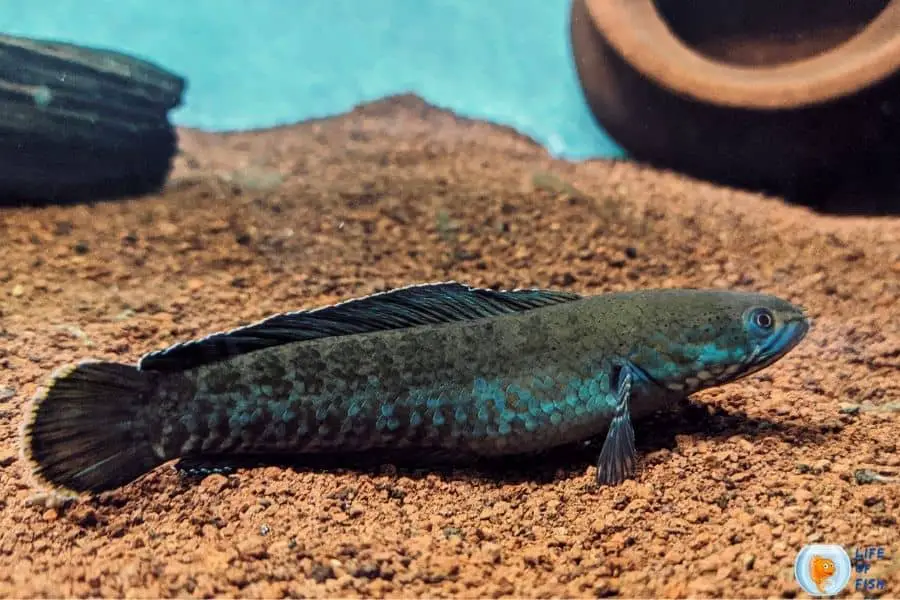
What is Snakehead fish?
Jump To
- 1 What is Snakehead fish?
- 2 Is it illegal to own a snakehead fish?
- 3 How big do Snakehead fish get?
- 4 Is Snakehead fish aggressive?
- 5 Snakehead fish behavior
- 6 How long do Snakehead fish live?
- 7 Snakehead fish varieties
- 8 Snakehead fish care
- 9 One look care guide
- 10 Snakehead fish breeding
- 11 How to feed Snakehead fish?
- 12 What fish can live with Snakehead fish?
- 13 Are Snakehead fish rare?
Snakeheads are ray-finned fish belonging to a freshwater perciform fish family (Channidae) that consists of more than 50 fish species under two genera.
One genus, Channa (ex northern snakehead), is native to Asia, while the other genus Parachanna is native to Africa.
Channa Snakeheads are most popular among these fish species in the aquarium trade because of their vivid coloration and their ability to survive for days out of water.
Snakeheads get their name from their snake-like flattened shape and scales on their head that looks like a snake.
They also have attractive long dorsal and anal fins that run the length of their bodies.
The snakehead fish is considered an invasive species in some regions because it has established itself in the wild after being introduced by humans.
This species’ ability to survive for days out of the water and traverse land while maintaining its gills active (to breathe air through the skin) contributes to its ability to establish itself in new habitats.
This capability allows the snakehead fish to survive anywhere there is water not far away, such as streams or drainage ditches.
Snakeheads also release an anti-freeze protein in their blood during winter freeze periods, protecting them from frostbite damage.
This protein remains intact even after freeze-thaw cycles, allowing the fish to recover if they thaw out quickly.
While they can survive in various habitats, snakeheads prefer to live in water with lots of vegetation and cover for protection from predators. Because of this, they are found most often in areas where the vegetation is dense.
In captivity, proper care should be taken to ensure that they receive enough plant cover and hiding spots.
Is it illegal to own a snakehead fish?
In most states in the United States, it is illegal to possess a live snakehead fish unless you have a special permit from the state Department of Wildlife.
For example, it is illegal for home aquarium owners to keep any non-native freshwater fish species in Virginia.
Many states have restrictions on keeping certain kinds or all kinds of exotic fish as pets, and many also prohibit the transport of these fish across state lines.
In states where it is illegal to keep live snakehead fish as aquarium pets, there are usually exceptions for those with a special permit from the state Department of Wildlife.
In Virginia, for example, the licenses allow only those individuals who have a public display facility or an educational institution to possess live snakeheads.
Snakeheads are also illegal in California because they are considered invasive fish that out-compete native species by the California Department of Fish and Wildlife.
It is illegal to possess any snakehead fish species without a permit from the Commission or to take, attempt to take, or transport them in violation of any law.
How big do Snakehead fish get?
Different snakehead species have different adult sizes. However, the maximum size of a snakehead is 1m.
Dwarf snakeheads are considered the smallest species. Dwarf snakeheads usually reach about 10 inches in length. Most other snakeheads grow up to 12 and 35 inches.
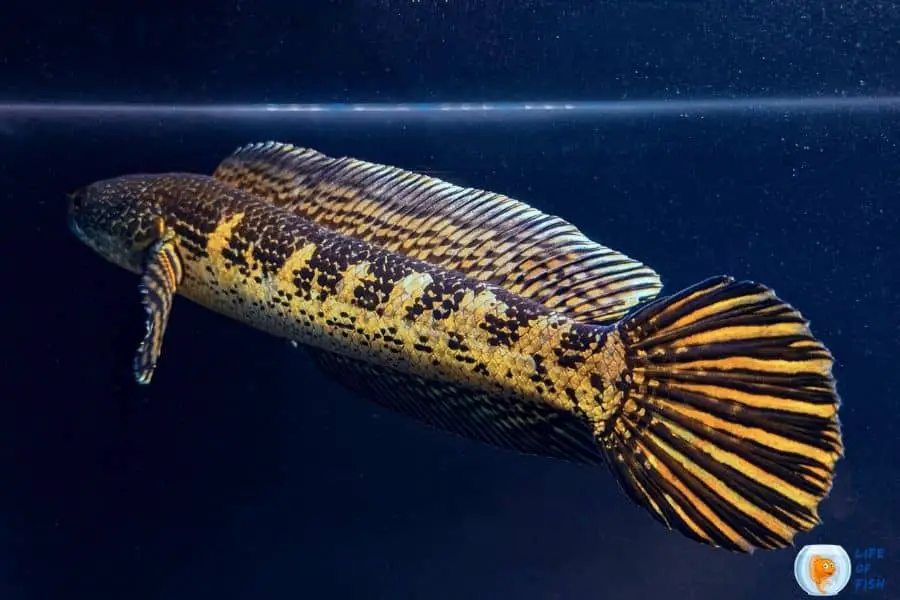
Is Snakehead fish aggressive?
Snakehead fish are known to be aggressive. Although most Snakehead varieties are aggressive, few species are docile.
For example, Channa gachua is a semi-aggressive fish that can get along in a community tank.
However, Channa marulius and Channa micropeltes (giant snakeheads) are considered very aggressive. Therefore, they should be kept in a species tank.
Snakehead fish behavior
Snakeheads are voracious predators that will chase down anything that moves in front of them.
This means that they will eat any fish or other aquatic creature smaller than them for food, so it is vital to choose the tank mates carefully.
Snakeheads are usually middle and bottom dwellers, so they will be at the tank level that has the most activity.
However, some species don’t behave rather actively. For instance, Channa micropeltes does not jump or swim around the tank very often.
Snakehead fish are excellent jumpers. They can certainly jump out of your tank and hurt themselves or your other fish if the tank is not well covered.
How long do Snakehead fish live?
On average, Snakehead fish may live up to 8 years. However, they tend to have a longer life span in captivity.
Snakehead fish varieties
As we said before, there are more than 50 species of snakehead fish living around the world. However, few species are popular in the aquarium trade. We have gathered a list of them below.
| Fish variety | Scientific name | Size | Temperament | Care Level |
| northern snakehead | Channa argus | 39 inches | Aggressive | Expert |
| Barca snakehead | Channa barca | 36 inches | Aggressive | Expert |
| Golden cobra snakehead | Channa aurantimaculata | 16 inches | Aggressive | Expert |
| Red Snakehead | Channa micropeltes | 39 inches | Very Aggressive | Expert |
| Dwarf Snakehead | Channa gachua | 8 inches | Semi Aggressive | Moderate |
| Emperor snakehead | Channa marulioides | 26 Inches | Semi Aggressive | Expert |
| Rainbow snakehead | Channa bleheri | 7.8 Inches | Semi Aggressive | Moderate |
| Banka snakehead | Channa bankanensis | 9 Inches | Aggressive | Expert (Highly Demanding) |
| Splendid Snakehead | Channa lucius | 15.7 Inches | Semi Aggressive | Moderate |
| Ocellated Snakehead | Channa pleurophthalma | 18 Inches | Relatively peaceful | Moderate |
| Spotted Snakehead | Channa punctata | 12 Inches | Aggressive | Expert |
| Chevron snakehead | Channa striata | 35 Inches | Aggressive | Expert |
| African Snakehead | Parachanna obscura | 18 Inches | Semi Aggressive | Moderate |
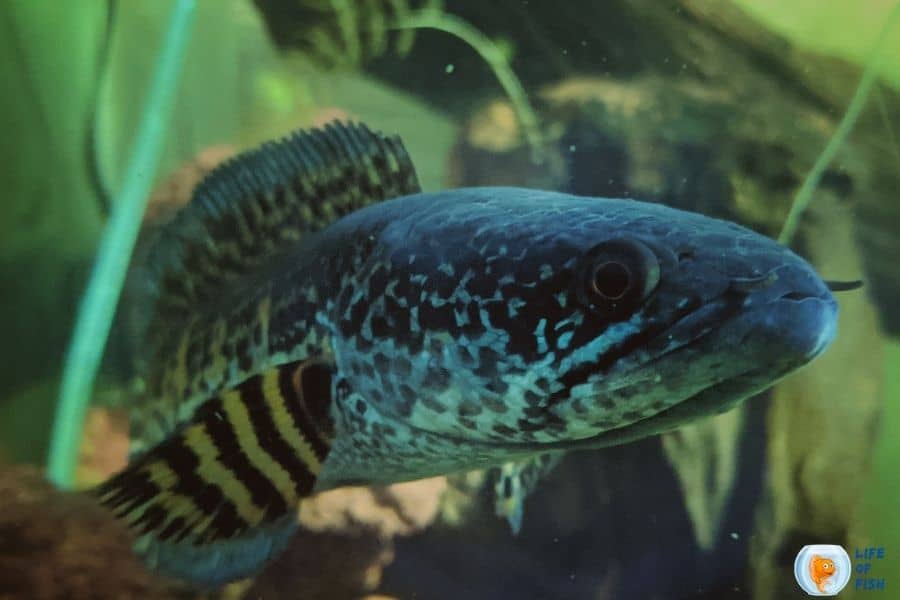
Snakehead fish care
Snakeheads are not demanding with water quality conditions. But, they require ample space with dense vegetation around them.
Snakehead fish size
The minimum size of a Snakehead is about 10 inches, and the maximum is about 3 feet.
However, the largest species are not popular in the aquarium trade. Most fish kept in aquariums are about 10 inches to 36 inches long.
Snakehead fish tank size
Snakeheads require a lot of space, so it’s essential to choose the tank size according to snakehead species.
For example, you can keep Dwarf snakeheads in a 120-gallon tank, but snakeheads like Channa micropeltes require a 450 to 1000 gallon tank.
How many Snakehead fish should be kept together?
Most snakehead species are solitary and aggressive. It is best to keep only one of them per tank. However, you may be able to house two fish in one tank if it is a breeding pair.
Tank setup
Snakeheads are tropical freshwater fish. Therefore, they prefer the same conditions in their habitats.
However, these fish can adapt to various water conditions. Further, they are pretty undemanding when it comes to tank decor. So, you can decorate your Snakehead tank as your heart desires.
However, these fish require aquatic vegetation in their habitats. The reason is pretty simple.
They like to hunt in the dense vegetation for their food. Further, aquatic plants provide them with the necessary oxygenation and shade during the daytime.
Examples of good tank decorations for snakehead fish are Anubias, Java Ferns, Water Wisteria, Hornwort, Vallisneria, Potamogeton, Echinodorus, Bacopa, Subwassertang, and Amazon Sword.
Snakeheads are very messy fish. Therefore, they will make your tank dirty in no time if you don’t keep it clean.
They like to fling their food around during feeding time, causing serious damage to the entire tank.
Therefore, weekly water changes along with a powerful filtration system are necessary.
Snakeheads are excellent jumpers. Therefore, a well-covered tank is a must. Further, it should have a top guard to prevent your fish from jumping out of the tank.
Water quality condition
Snakeheads can adapt to a wide range of temperature and water conditions, but their optimum temperature is 75°F to 82°F.
In general, Snakeheads prefer the same water conditions as tropical freshwater fish. However, they can tolerate brackish water better than other freshwater fish.
Snakeheads can live in an extensive range of pH, but their optimum pH level is 6.0 to 7.0. Their natural habitats have soft water.
So, they prefer about 8GH and 10°dGH in the aquarium. However, keep in mind that they can adapt to a wide range of water conditions.
But that doesn’t mean that you can keep them in foul water. As with other fish species, Snakeheads also need clean (at least to some extent) water conditions to thrive.
Otherwise, they will suffer from health disorders.
One look care guide
| Scientific name | Channidae |
| Common name | Snakehead fish Head snake fish |
| Care level | Expert |
| Native to | Asia and Africa |
| Type | Freshwater Perciform fish |
| Color | Vary by species |
| Tank size | 120 gallons for Dwafe Snakeheads 450 gallons minimum for larger species |
| Preferred temperature | 75°F to 82°F |
| Other water parameters (ammonia, etc.) | pH level: 6-7 Hardness: 8GH – 10°dGH |
| Preferred salinity | Can survive in brackish waters |
| Size | From 10 inches to 3 feets |
| Life span | Up to 8 years |
| Temperament | Aggressive |
| Recommended tank mates | None. Best suited in a species-only tank. |
| Preferred food | Live food |
| Feeding frequency | Once per day |
| Breeding | Easy, Egg-laying mouthbrooders |
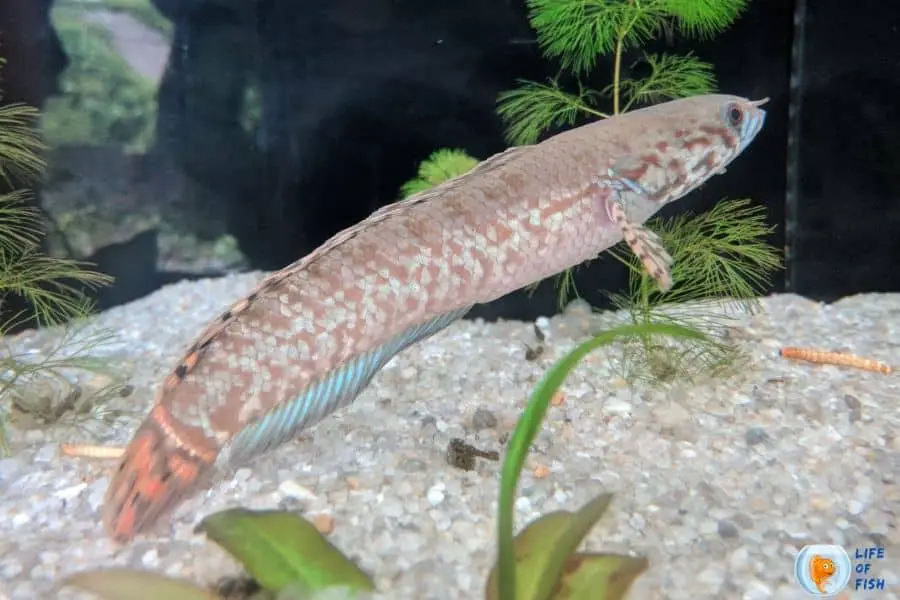
Snakehead fish breeding
Snakeheads are easy to breed and often lay eggs on time when given enough water conditions and tank space. However, determining the sex of snakeheads is occasionally tricky.
Snakehead fish male or female identification
The general rule of a female specimen of any fish species is true with Snakeheads too.
Female fish are generally larger and plumper than male fish. However, because of their hefty size, it is not easy to actually identify female fish.
You can also identify Snakehead’s sex according to their behavior patterns:
- If you see your snakeheads chasing each other or quarreling with someone, then it is likely that they are trying to mate.
- If you see your snakeheads spawning, then they are a most likely couple. However, if their behavior is more aggressive, the fish might be trying to defend their territory against the intruder.
Identify pregnant Snakehead fish and Snakehead fish pregnancy stages
Snakeheads are Egg laying mouthbrooders. When the female Snakehead is ready to spawn, her belly will become plumper.
Further, her color will become more brilliant. The female fish becomes visibly pregnant during the spawning time.
Snakehead fish breeding
To breed Snakehead in captivity, you first need to house a breeding pair in one tank. This is usually difficult because it isn’t easy to identify male and female fish.
Otherwise, it is pretty easy to breed these fish in captivity when given plenty of space and ideal water conditions.
When conditions are ideal, you can see the pair spawning just like other mouthbrooders.
The female Snakehead lays eggs, and then the male fertilizes them. You can keep both parents in the tank as both of them protect the eggs.
The male fish keeps the eggs in his mouth while the female protects them from intruders.
They will keep protecting them even after the eggs hatch and fry become free-swimming.
How many babies do Snakehead fish have?
Snakehead fish will lay as much as 15000 eggs in a spawning session. However, many eggs will not develop.
Snakehead fish fry care
Snakeheads, as other mouthbrooders, will continue to protect their fry. However, they can eat small fish as well as eggs if the conditions are too crowded.
So, it is advisable not to introduce any new fish in the tank or keep any other adult fish with them during this time.
The parents release the fry when they can feed themselves. So, continue to provide them with fry food, and they will eventually release them.
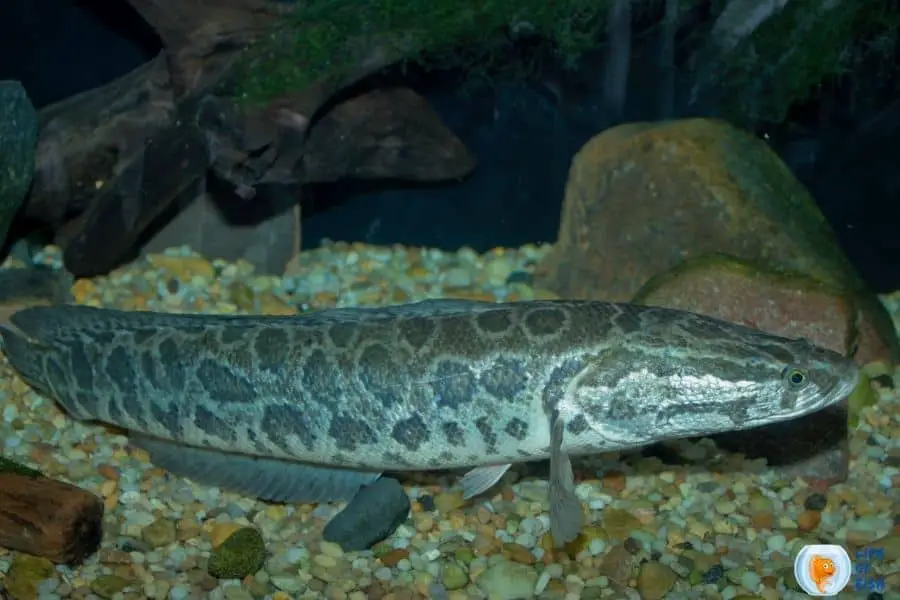
How to feed Snakehead fish?
Snakeheads are voracious eaters that will eat any live thing in their path when it comes to food.
It is best to feed snakeheads once a day in the morning when they are most active. Make sure that you provide them enough as they are fast-growing fish.
After some time, you can acclimate these fish to eat frozen and freeze-dried food like other tropical fish species. But, during the initial days, try to stick to live foods like insects and worms.
What fish can live with Snakehead fish?
Snakeheads are very territorial fish. Thus, you should keep only one Snakehead per tank as they will attack any fish that enters their territory.
However, you can give them some time to adjust to their new tank mate. If they get along, you can add another snakehead to your tank.
You should avoid keeping snakeheads with any kind of slow-moving fish because its prey will be right under its nose, waiting to be eaten.
The pet fish that will do well with the Snakehead are large-sized species like catfish and cichlids.
Again, this is only possible with small-sized snakeheads like Dwarf Snakeheads and Ocellated Snakeheads.
If you want to keep large snakeheads in your tank, then you are out of tank mate options. You can only keep one Snakehead in your tank like Piranhas.
When picking out a companion for your Snakehead, choose a faster or larger fish than your Snakehead.
Alternatively, you can also keep other aggressive species with them as these will drive away other fish if they approach your territory.
Are Snakehead fish rare?
Some snakehead species like Nothern Snakehead are not rare and have become invasive outside their native habitats (especially in the USA).
However, some species like the Ceylon snakehead (Channa orientalis) are rare and listed as vulnerable by the IUCN Red List.
Read Next : African Leaf Fish Tank Mates | 10 Perfect Matches For Them |
